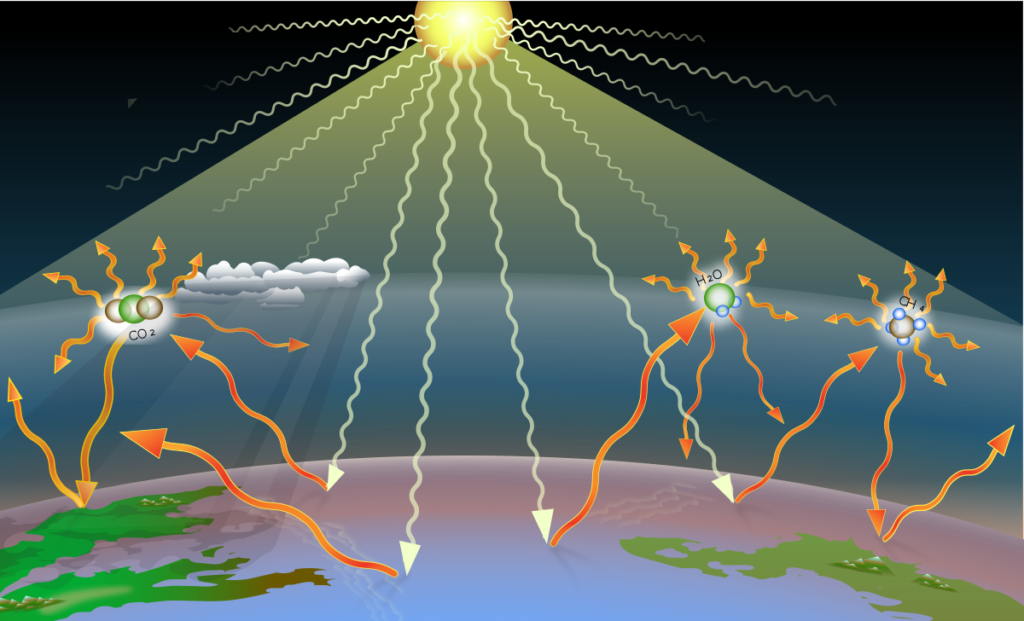What Is The Greenhouse Effect
Without the natural greenhouse effect on Earth, life as it exists today would not be possible. In order to understand the cause and effects of global warming, it is first necessary to understand the Earth’s natural greenhouse effect and the roles of the various greenhouse gases, such as carbon dioxide (CO2). This chapter looks at the difference between the Earth’s natural greenhouse effect and the enhanced greenhouse effect and illustrates why and how humans are contributing to a global problem destined to ruin the health of the planet if not stopped. It also looks at the issue of global dimming, what it is, what causes it, its interaction with global warming, and what it means for the future.
Discovery of the Greenhouse Effect
Is was during the 19th century that scientists realized that gases – such as CO2 – found within the atmosphere cause a “greenhouse effect” that regulates the atmosphere’s temperature. Ironically, the discovery of the greenhouse effect did not happen because scientists were trying to understand global warming; it happened because they were searching for the mechanism that triggered ice ages. In an effort to understand the connection between CO2 and glacial periods, their interest was in studying the time intervals when concentrations of CO2 were at their lowest, which correlated with the glacial periods in the Earth’s past climate.
The beginning of the discovery process began with Joseph Fourier in the 1820s. During this time period, scientists were beginning to understand that the gases that composed the atmosphere may trap the heat received in the atmosphere from the sun.
Also at this time, John Tyndall, a natural philosopher, was interested in finding out whether any gases in the atmosphere could actually trap heat rays. In 1859, through a series of lab analyses, he was able to identify several gases that were able to trap and hold heat. The most important of these gases were water vapor (H2O) and CO2.
Later, in 1896, Svante Arrhenius, a Swedish chemist/physicist, who was working with data on the prehistoric ice ages, was able to determine in his laboratory that by cutting the amount of CO2 in the atmosphere by half, it could lower the temperature over Europe about 7-90 F (4-50C) – roughly the equivalent of what would trigger another ice age.
In order for this to happen, however, the effect would have to be global. From this point, Arrhenius turned to Arvid Hogbom, who added a modern twist to the analysis. He discovered that various human activities were adding CO2 to the atmosphere at a rapid rate. At that time, he thought that the addition was not serious enough for alarm – it was not much different from other natural processes like erupting volcanoes. What he was concerned about, however, was that if the erupting volcanoes continued being released into the atmosphere, it would not be long before they did start to negatively affect its quality. Arrhenius suggested that at the current rate of coal burning, the atmosphere could begin to start warming a few centuries.
About the time, Thomas C. Chamberlin, an American geologist, became interested in atmospheric CO2 levels, and the Swedish scientists Knut Angstrom discovered that greenhouse gases do cause temperature to rise by retaining the heat instead of letting it escape to space. This added additional enlightenment to the beginning of the global warming theory.
The Greenhouse Effect
The earth needs the natural greenhouse effect. It is the process in which the emission of infrared radiation by the atmosphere warms the planet’s surface. The atmosphere naturally acts as an insulating blanket, which if able to trap enough solar energy to keep the global average temperature in a comfortable range in which to support life. This insulating blanket is actually a collection of several atmospheric gases, some of them in such small amounts that they are referred to as trace gases.
The framework in which this system works is often referred to as the greenhouse effect because this global system of insulation is similar to that which occurs in a greenhouse nursery for plants. The gases are relatively transparent to incoming visible light form the Sun, yet opaque to the energy radiated form the Earth.
These gases are the reason why the Earth’s atmosphere does not scorch during the day and freeze at night. Instead, the atmosphere contains molecules that absorb and reradiate the heat in all directions, which reduces the heat lost back to space. It is the greenhouse gas molecules that keep the Earth’s temperature ranges within comfortable limits. Without the natural greenhouse effect, life would not be possible on Earth. In fact, without the greenhouse effect to regulate the atmospheric temperature, the Sun’s heat would escape and the average temperature would drop from 570F to -2.20F (140C to -180C); a temperature much too cold to support the diversity of life exists today on the planet.
More Related Post
- Green Revolution In Hindi
- What Is The Greenhouse Effect
- Madhya Pradesh Places To Visit
- Short Note On Global Warming
- What is the Difference Between Debit Card and Credit Card
- Nobel Prize of Physics
- Houska Castle | होउस्का कैसल | नर्क का द्वार
- International Olympic Day 2021
- Yogi Adityanath Biography | Biography of Yogi Adityanath
- रामधारी सिंह ‘दिनकर’
